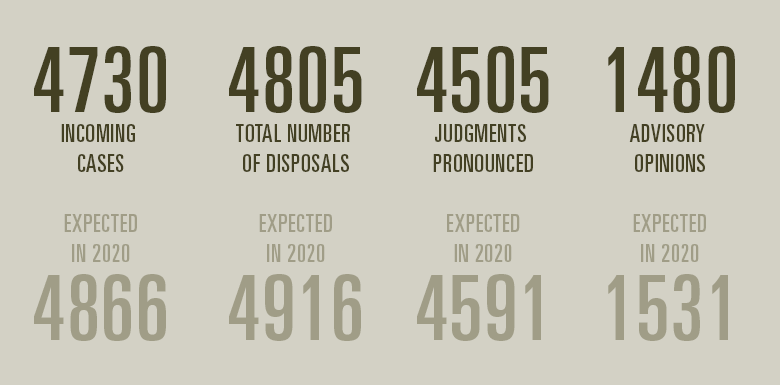2020, the year in which the health crisis began
The work continued
2020 was dominated by the health crisis caused by coronavirus. The judicial system was confronted with many new and urgent issues, a clear illustration of the vital function it plays in society. District courts, appeal courts and the Supreme Court are themselves organisations that have had to deal with the practical internal problems presented by the pandemic. In the reporting period the Supreme Court, like many other bodies, had to find its bearings at a time of uncertainty, while working within the restrictions announced by the government in an attempt to control the spread of coronavirus. The Supreme Court enforced these restrictions within its own organisation, while making every effort to ensure that its primary task of administering justice continued. Most of the justices and staff worked at home from mid-March 2020. Consultations took place remotely using digital technology. Social distancing (1.5 metres) was observed in the building. After a brief period in which they were suspended and then held online, the Civil, Criminal and Tax Divisions’ weekly discussions in chambers resumed in the Supreme Court building subject to the coronavirus restrictions, while electronic devices were supplied to those who, for whatever reason, had to work from home.
Incoming cases and disposals
The Supreme Court’s own experience and the figures for 2020 show that the Court has continued to function effectively during the pandemic. The overall impression is that compared with previous years, the Court remained on course, the incoming cases and disposals were more or less in balance and the expectations for this year were met.

You can find more information and explanation of the 2020 figures at Cijfers en verantwoording.
Digital workplace
The fact that the Supreme Court continued to function effectively in 2020 is to a large extent thanks to digital technology.
Parties to proceedings can litigate digitally before the Supreme Court. This was possible before 2020 in civil claims and some criminal cases. As of 1 February 2020 it became possible in all criminal cases and from April 2020 in cases brought before the Tax Division (Dutch news item). In view of the coronavirus restrictions, the decision was taken to open the online portal on a temporary basis to civil petitions as well, in anticipation of the introduction of the definitive arrangement for digital proceedings in such cases on 1 April 2021.
In April 2020 the Minister for Legal Protection, Sander Dekker, was due to attend festivities to mark the opening of an online portal for tax cases. Unfortunately, the coronavirus restrictions meant this could not go ahead. The minister extended his congratulations to the Supreme Court through the video message below, emphasising once again the importance of digital proceedings.
Another aspect of the Supreme Court’s digital workplace is that justices and staff have years of experience in using the system that stores and allows access to digitalised case files. In addition, the Court has an extensive digital knowledge centre including legal databases and an electronic library. People working from home can access these systems and work on current cases. When in March 2020 the Supreme Court moved to virtually full-time working from home, many of the staff and justices had to find new ways of consulting colleagues and remaining in contact.
The Supreme Court’s offices were made ‘coronavirus-proof’ for those staff whose presence was essential, for example to deal with mail. Arrangements were made to allow them to consult online with colleagues working from home.
Right to a public hearing
In 2020 the Supreme Court managed to safeguard the right to a public hearing even during the months that the building was closed for public health reasons. Judgments were pronounced in the weekly case list sessions, which were open to the parties and (to a limited extent) to the media. Judgments were also made available to the parties in the usual way. Judgments are published as soon as possible after being handed down and anonymised. In practice, publication takes place on the date on which judgment is given or, at the latest, the day after. This remained the case when most people were working from home due to the coronavirus restrictions. Furthermore, the aims served by a public hearing (foreseeability and verifiability of the law) were also guaranteed in this way.
As a result of the coronavirus restrictions, the number of available seats in public areas was limited. In the interests of the public nature of hearings, the Court used live-streaming on a number of occasions in 2020, in light of the legal and societal importance of making proceedings accessible to a larger number of people and taking account of particular public interest in certain cases. Live-streaming is a simple way of bringing cassation proceedings closer to members of the public and the media. In 2020 it was used several times when judgment was given and in oral pleadings involving a large number of parties who could not all be accommodated in the courtroom. Experience to date with live-streams will be used to further develop the Supreme Court’s communication policy.
Impact on the administration of justice
In the first few months of 2020 it became clear that the COVID-19 health crisis had led to far-reaching restrictions on people’s lives. This had an impact on the judicial system. Did existing legislation provide an adequate basis for making decisions according to the circumstances of the case? What did new, hurriedly enacted legislation mean for pending cases? Could the lower courts deviate from existing rules of law in daily practice? Such questions also reached the Supreme Court. The relevant cases were heard as a matter of priority so as to offer the greatest possible clarity to lower courts and the legal profession in a period of unprecedented uncertainty. For more information see COVID-19 and the administration of justice.